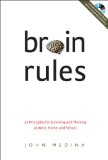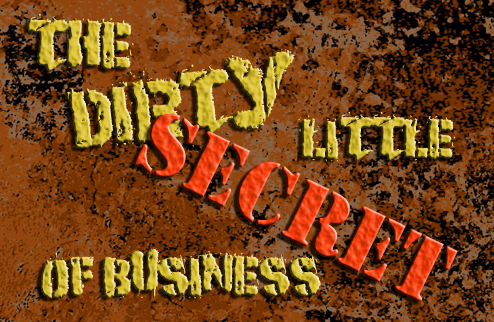
Wednesday, January 7













|
Home > Leadership in the Real World Blog | |
|
Notes, links, and inspiration about topics related to personal and leadership development. |
|
|
| |
Death By PowerPoint (or video or....)I know, I know... everybody knows that PowerPoint is all too often abused. Though we are aware of the crime, death by PowerPoint remains way too commonplace in everyday corporate life. This slide show at CIO Magazine's website is a good reminder for us all. John Medina's book Brain Rules: 12 Principles for Surviving and Thriving at Work, Home, and School does a great job of explaining why good slide manners matter. Get his book, but also check out the "Vision" video on his website. John Medina's book Brain Rules: 12 Principles for Surviving and Thriving at Work, Home, and School does a great job of explaining why good slide manners matter. Get his book, but also check out the "Vision" video on his website.My observation: the problem isn't just poor slide design. It often starts with a misunderstanding of how to architect an effective message. I watched a video that a friend posted on YouTube to talk about a company that his organization will be partnering with in 2010. It wasn't clear to me whether he was targeting the video for existing customers, prospective customers, or people who want to buy into his franchise idea. On Monday Night Football this week, IBM paid hundreds of thousands of dollars to show a couple of their Smarter Planet ads, such as this one. Though I find the ads intriguing, it led to an equally intriguing discussion with some friends and family: what is it that IBM actually does these days? I could answer that 25 years ago. Today? I'm not as sure. To whom are they targeting that ad? Is it worth the cost? The smart minds behind the Smarter Planet initiative clearly think so. I'm not as convinced, based on the discussion around our munchies Monday evening. My point: whether it's a presentation, a video, an e-mail, a marketing piece, or any other communication, start with the basics: who is my target audience and which of their problems am I addressing? How can I best communicate how we address those problems? If you can't clearly answer those initial questions, it really doesn't matter how slick (or sick) your PowerPoint slides (or video or....) looks. The message will get lost in the fog. Do you have a favorite abuse of PowerPoint (or video or web page or....)? Send me a pic or link! Here's to your success communicating today! Labels: communication, influence, marketing, presentations
| |
You Are Who You...... spend the most time with. Do you buy that? In my keynote entitled The Dirty Little Secret of Business, we talk about the importance of relationships. During the keynote I ask people in the audience: "How much does it matter who you spend time with? Why?" In my keynote entitled The Dirty Little Secret of Business, we talk about the importance of relationships. During the keynote I ask people in the audience: "How much does it matter who you spend time with? Why?"Overwhelmingly the responses are that we are significantly impacted by the people we are surrounded by. Speaker and author Allan Holender says it this way: "You are the mean of the five people you spend the most time with." As you look around your office, this might scare you. :) This principle goes beyond just the workplace or even adults. A study released earlier this month found that kids with overweight friends tend to be overweight as well. In the keynote I challenge people to be more intentional with whom they surround themselves. You may not be able to select the members of your team, but you do have control over who you go to lunch with, what podcasts you listen to, which books you read, and who you hang out with socially. We talk about the importance of diversity in relationships and finding people who make you better, not tear you down... who take your further, not hold you back... who you can help as well as they can help you.  Andy Stanley says, "What and who you listen to will determine what you do." Even if this isn't completely true in every situation, I'm convinced from my own experience (as well as from coaching hundreds of executives), that much of your success will come down to who your greatest influencers are. And you are most influenced by those you spend the most time with. Andy Stanley says, "What and who you listen to will determine what you do." Even if this isn't completely true in every situation, I'm convinced from my own experience (as well as from coaching hundreds of executives), that much of your success will come down to who your greatest influencers are. And you are most influenced by those you spend the most time with.Take a look around. P.S. If you would like more information about our Dirty Little Secret of Business keynote, contact me for details. It's a perfect session for company or department meetings, offsite meetings, and conferences. Labels: culture, influence, keynotes, leadership, listening, relationships
| |
What I "Can" Do There are times when saying 'No' seems like a career-limiting move. Yet a clear personal productivity principle is learning to say 'No'. There are times when saying 'No' seems like a career-limiting move. Yet a clear personal productivity principle is learning to say 'No'.Easier said than done. I often cover this topic in our project management and leadership development workshops. Here's a link to my article "How to Say 'No' (Without Saying 'No')" that provides some helpful advice. In addition, here's a piece from Rachel Zupek for your consideration as well. I like her focus on "What I can do..." as well as the coaching on watching your body language and vocal tone. Clearly there are times when "No" needs to be the answer (for example, when asked to do something illegal, unethical, or against your value system). Yet some people err on the side of over-using "No" when there may be better ways to finesse the same result. Ultimately, we need to be known as people who deliver--who make things happen. That will often happen by saying "Yes" to opportunities. But when "No" is really the best answer, it's helpful to be armed with techniques that can help you influence a "No" without always using the letters N-O! Labels: communication, influence, managing stakeholders, managing up, time management
| |
Two Words That Can Improve Your InfluenceCan a couple little words really make a difference in your ability to influence someone, such as a customer or stakeholder?I just read a summary of Jeff Mowatt's new book Influence With Ease. Though I'm not recommending it as an addition to your reading list, I did appreciate the reinforcement that small changes to how we phrase things can make a big difference. Pop Quiz: What two words helped waiters and waitresses to increase their tips by 12%? "Thank you" comes to mind. In this article Mowatt talks about using the phrase "for you." Waitresses who said "I brought more coffee over for you" notably increased their tips over those who asked "Would you like more coffee?" Using "for you" helps the service to feel more personalized.
In a sense this calls back to what Dale Carnegie taught us decades ago in How to Win Friends and Influence People: "You can make more friends in two months by becoming interested in other people than you can in two years by trying to get other people interested in you." (By the way, here's a recommendation for you: add Carnegie's book to your must-read list if you either haven't read it or haven't gone over it again in the last 5 years.) You can radically improve your influence by focusing on the other person and their needs instead of yourself and your needs. Though there's no phrase that will magically get others to comply in every situation, consider adding a little "for you" into your comments this week.We offer keynotes and workshops that can help you and your team improve your ability to influence, even when you don't have authority. Contact us today to learn more. Labels: influence, leadership
| |
How to Say "No" (Without Saying "No") So, how do you say "No" when doing so feels like it could be, say, a career limiting move? Advice abounds, often over-simplifying the stakes by not taking into account the complexities of saying "No" to someone like a boss or by not giving specific enough strategies. So, how do you say "No" when doing so feels like it could be, say, a career limiting move? Advice abounds, often over-simplifying the stakes by not taking into account the complexities of saying "No" to someone like a boss or by not giving specific enough strategies.In a recent newsletter article I give some practical ways to say "No" without saying the letters N-O. Here's your chance to join the conversation: How do you handle situations when everything inside of you wants to say "No", but there are other pressures to say Yes? Add a comment to this blog entry to share your insights. Labels: accountability, conflict, denial, executives, influence, leadership, managing up, project sponsors
| |
What Shamu Can Teach You About Your BossOne of the dirty little secrets of managing is that, over time, you'll do more managing up and out than down. But that's easier said than done. What are some important lessons learned about managing up?I recommend Dan and Chip Heath's article in FastCompany entitled, "Your Boss is a Monkey". They take lessons from Amy Sutherland's book What Shamu Taught Me About Life, Love, and Marriage and apply them to managing "another irritable mammal: your boss." A couple observations that aligns with how we coach leaders:
Keep in mind that the "monkey" article's advice to "ignore the bad behavior" has limitations. There's wisdom in not over-reacting. Counting to 10 (or 100) has saved many careers! Yet "apparent indifference" does not always "smother the fire." In fact, for some bosses, it will pour fuel on the fire as it sends the signal that you don't care. Though the Heaths discount aligning styles and expectations as techniques, there is enormous leverage in understanding the art and science of such approaches. They are too critical to chalk up as "goody-two-shoe" training grovel. Want to learn practical skills on how to manage up more effectively? Join our Leadership Fast Track Program starting in June! Click here for details! Labels: accountability, conflict, executives, influence, leadership, learning, managing up, personality styles
| |
How the Conflict in the Taxi Ended In a recent newsletter I related a true story of conflict that happened in a taxi on a cold night in Boston. If you haven’t read the story, click here to read it before continuing (it takes 2 minutes or less). In a recent newsletter I related a true story of conflict that happened in a taxi on a cold night in Boston. If you haven’t read the story, click here to read it before continuing (it takes 2 minutes or less).So, how did I respond when the driver spewed, “No! You said Hampton Inn at the airport!” I first took a deep breath to keep from lashing out. After all, my family was in the backseat and it was important that I not do anything that puts them in danger. I knew that more than my (now nervous) wife was in the back seat. Three little ones were watching what Dad was going to model. I looked into the driver's eyes, replied firmly but respectfully, “No, I said Monsignor O’Brien Highway. Take us to the Hampton Inn on Monsignor O’Brien Highway, now.” He wasn’t happy but he did take the next right turn. We were suddenly in a dark, rough looking neighborhood that I’m sure didn’t do much to settle my wife’s nerves! I pulled out my cell phone and called our hotel. In a voice loud enough to make sure the driver heard, I asked the front desk approximately how expensive a taxi fare from our origination to the hotel should cost. I repeated the answer out loud, “Did you say $15? Thank you.” The taxi fare was already over $20, with at least 10 minutes to go. As if I thought he hadn’t heard me (you never know with this driver!), I calmly but firmly told him, “I will be paying you $15 for this trip.” I didn’t have to speak his language to understand the essence of what was said under his breath. I didn’t respond. We were never so happy to see a Hampton Inn. The family poured out of the backseat with a collective sigh. The driver knew he wouldn’t get his $35 taxi. Much to his surprise, I pulled out a $20 bill and told him to keep the change. A bit stunned, he responded, “I’m sorry for the mistake.” Not all conflict ends quite this amicably. Enjoy it when it does. Though I don’t naturally use a Competing conflict style often, a controlled version of it worked in this case, followed by a Compromising pay out at the end. We can help you learn to manage conflict with more confidence. Our Beyond the Rock and the Hard Place can be delivered in a keynote, workshop, or e-learning formats. Click here for more information. Labels: Beyond the Rock and the Hard Place, conflict, crisis, influence, leadership
| |
Improving Your InfluenceHow effective are you at influencing others? How can you convince someone to agree to your proposed approach, particularly when you don't have authority over them? Or when it's not as simple as getting a bunch of facts together? Or when there may be some natural tension between what you both want? Ever get free return mailing labels from an organization asking for donations? How about free samples where you shop? As it turns out, Cialdini finds they all may not be as free as we think! In fact, researchers have found that simply giving customers a candy or mint along with their bill significantly increases tips! Actions for Leaders
Labels: Books I Love, conflict, influence, leadership, managing stakeholders
| |
What Shamu Can Teach You About Your BossOne of the dirty little secrets of managing is that, over time, you'll do more managing up and out than down. But that's easier said than done. What are some important lessons learned about managing up?I recommend Dan and Chip Heath's article in FastCompany entitled, "Your Boss is a Monkey". They take lessons from Amy Sutherland's book What Shamu Taught Me About Life, Love, and Marriage and apply them to managing "another irritable mammal: your boss." A couple observations that aligns with how we coach leaders:
Keep in mind that the "monkey" article's advice to "ignore the bad behavior" has limitations. There's wisdom in not over-reacting. Counting to 10 (or 100) has saved many careers! Yet "apparent indifference" does not always "smother the fire." In fact, for some bosses, it will pour fuel on the fire as it sends the signal that you don't care. Though the Heaths discount aligning styles and expectations as techniques, there is enormous leverage in understanding the art and science of such approaches. They are too critical to chalk up as "goody-two-shoe" training grovel. Want to learn practical skills on how to manage up more effectively? Join our Leadership Fast Track Program starting in June! Click here for details! Labels: accountability, influence, leadership, personality styles |
|
|


 John Maxwell summarizes leadership in one word: Influence. One of my favorite books on the topic is from Robert B. Cialdini. In Influence: The Psychology of Persuasion, Cialdini offers up what he calls the "weapons of influence" to help us all better understand how influence works.
John Maxwell summarizes leadership in one word: Influence. One of my favorite books on the topic is from Robert B. Cialdini. In Influence: The Psychology of Persuasion, Cialdini offers up what he calls the "weapons of influence" to help us all better understand how influence works. It's reciprocity in action.
It's reciprocity in action.